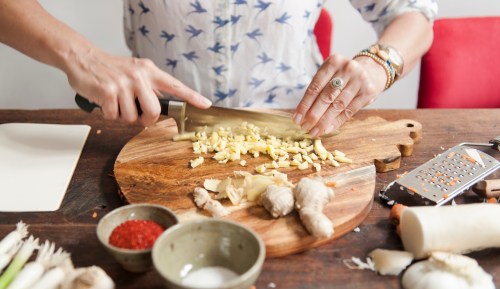This Brilliant Cooking Tip Doubles the Anti-Inflammatory Benefits You’ll Reap From Ginger
Ginger peels are the most potent part of the anti-inflammatory herb. See how to use ginger peels in your cooking to benefit.

Ginger is a mainstay in cooking year-round, but the warming spice is especially appreciated this time of year, popping up in everything from baked goods to golden curries and veggie-filled stir fry. Comfort food—in all its glorious forms—is ginger’s specialty.
Experts in This Article
Kanchan Koya, PhD, is a certified health coach and the founder of Spice Spice Baby Limited. She also has a Doctorate in Molecular Biology from Harvard Medical School.
It’s also one of the first spices worth reaching for on a sick day. (It is that time of year…) Experiencing some tummy troubles? Ginger can help. Feel a sore throat coming on? Ginger’s got you. And those are just of a few ways it’s beneficial. “Studies have shown ginger to be effective in decreasing inflammation, swelling, and pain, thanks to a compound called gingerol,” Tracy Lockwood-Beckerman, RD, previously shared with Well+Good. Here’s the thing though: Most people miss out on the most powerful part of the herb by throwing it away.
Watch the video below to learn more about the health benefits of ginger:
Recently, chef, health coach, and Harvard-trained biologist Kanchan Koya, PhD, shared on social media that ginger peels are the most potent part of the plant—and a lot of the time they end up down the garbage disposal. “Ginger peel is edible. It contains twice the beneficial polyphenols as the flesh and importantly, unique and distinct compounds,” she says. One scientific study even found that consuming ginger peels has been linked to helping prevent colon cancer.
While eating the ginger peels directly isn’t going to be appetizing to most people, Dr. Koya says that when it comes to how to use ginger peels, there are still plenty of ways. “Anything where you won’t directly be eating the peel and can either strain (like a broth) or puree (like a soup) would work,” she says, adding that you can also blend the peels into your smoothie, use them to make ginger tea, or learn how to make ginger oil for soothing aches and pains.
When it comes to actually peeling the ginger, Dr. Koya recommends using a spoon instead of a knife. “That way you avoid taking off excess flesh with the peel,” she says. Tips for how to peel ginger is also a topic that has come up in Well+Good’s Cook With Us Facebook group, a community devoted to sharing healthy recipes and cooking tips with each other. One member shared that it helps to soak the ginger in water overnight. (You can use the water to cook with too, as it will then have some of ginger’s anti-inflammatory properties.) She also recommended cutting the roots off and tossing them into a blender with a little water. Then, she freezes the liquid in ice cubes to use in her cooking later. Smart, right?
Dr. Koya emphasizes that what’s most important is finding ways to use the entire plant. “Use both the ginger flesh and the peel when you can,” Dr. Koya says. Not only does it cut down on food waste, but you’ll get twice the health benefits than you would otherwise. Talk about spicing up your life!
Oh hi! You look like someone who loves free workouts, discounts for cutting-edge wellness brands, and exclusive Well+Good content. Sign up for Well+, our online community of wellness insiders, and unlock your rewards instantly.
Sign Up for Our Daily Newsletter
Get all the latest in wellness, trends, food, fitness, beauty, and more delivered right to your inbox.
Got it, you've been added to our email list.










